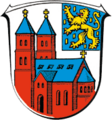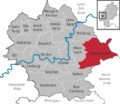Weilmünster facts for kids
Quick facts for kids
Weilmünster
|
||
|---|---|---|

Panorama of Weilmünster
|
||
|
||
| Country | Germany | |
| State | Hesse | |
| Admin. region | Gießen | |
| District | Limburg-Weilburg | |
| Elevation | 193 m (633 ft) | |
| Population
(2022-12-31)
|
||
| • Total | 8,916 | |
| Time zone | CET/CEST (UTC+1/+2) | |
| Postal codes |
35789
|
|
| Dialling codes | 06472 | |
| Vehicle registration | LM, WEL | |
| Website | www.weilmuenster.de | |
Weilmünster is a town in the Limburg-Weilburg area of Hesse, Germany. It's a lovely place with lots of forests and a long history.
Contents
Exploring Weilmünster's Location
Weilmünster is known for its many forests. The local forestry office helps manage not only the state forests but also woodlands for twelve towns in the Limburg-Weilburg and Lahn-Dill districts.
Where is Weilmünster Located?
This market town sits on the northern side of the Taunus mountains, in the valley of the Weil River. The Weil River flows into the Lahn River. Big cities nearby include Wetzlar (about 20 km northeast), Limburg (about 25 km west), and Frankfurt am Main (about 50 km southeast).
What Towns are Near Weilmünster?
Weilmünster shares its borders with several other towns. To the north are Weilburg and Braunfels. To the east is Waldsolms. South of Weilmünster, you'll find Grävenwiesbach, Weilrod, and Selters. To the west are Villmar and Weinbach.
Weilmünster's Villages and Communities
Weilmünster is the main part of a larger community with about 10,000 people. It includes twelve smaller villages, also called Ortsteile. These villages are Audenschmiede, Aulenhausen, Dietenhausen, Ernsthausen, Essershausen, Laimbach, Langenbach, Laubuseschbach, Lützendorf, Möttau, Rohnstadt, and Wolfenhausen. A long time ago, Heinzenberg was also part of Weilmünster, but now it belongs to Grävenwiesbach.
A Look into Weilmünster's Past
Weilmünster was first mentioned in official papers in 1217, under the name Wilmunstre. However, it was already a good-sized village with its own church by then. Some history experts believe that the Fulda Monastery, which owned land in the village, built this church around the 800s.
The church you see today was built in the early 1500s. Its strong, square tower, which was used for defense, was built around 1300. Weilmünster has been a place for markets since at least 1601. The community was part of the House of Nassau family's lands. Later, it joined the Duchy of Nassau in 1806. In 1866, it became part of Prussia and the Province of Hesse-Nassau.
How Industry Shaped Weilmünster
Industry started early in Weilmünster. In the early 1500s, there was an ironworks with a blast furnace here. Later, other metalworking businesses and foundries opened. However, this industrial growth didn't last long. While other areas got better roads and river routes, Weilmünster was left behind because it wasn't on these main paths. The "Weil Road" was built in 1860, but it was too late. The railway didn't even reach Weilmünster until 1908.
In 1421, there was a smithy in Audenschmiede. This smithy grew into a very important one across the country. In 1798, it became part of the Buderus company and was one of their most important locations until 1930.
Weilmünster's History in the 1900s
In the 1970s, the old community of Weilmünster joined with other nearby communities to form the larger Weilmünster we know today.
Many of Weilmünster's villages have very old histories. Möttau was first mentioned in 802, Laubuseschbach in 897, and Wolfenhausen in 1194. Other villages like Essershausen (1233), Lützendorf (1234), Dietenhausen (1301), Ernsthausen (1309), Laimbach (1344), Langenbach (1335), Rohnstadt (1355), and Aulenhausen (1565) also have long histories.
Weilmünster's Government and Symbols
How Weilmünster is Governed
The local government in Weilmünster is chosen by its citizens. Here are the results from some past elections:
| Political Groups | % 2006 |
Seats 2006 |
% 2001 |
Seats 2001 |
|
| CDU | Christian Democratic Union of Germany | 41.2 | 13 | 40.5 | 13 |
| SPD | Social Democratic Party of Germany | 43.1 | 13 | 43.3 | 13 |
| BL | Bürgerliste FWG-F.D.P. | 15.7 | 5 | 10.9 | 3 |
| GREENS | Bündnis 90/Die Grünen | – | – | 5.2 | 2 |
| Total | 100.0 | 31 | 100.0 | 31 | |
| Voter turnout in % | 48.4 | 56.9 | |||
In the 2016 elections, the seats were divided as follows:
- CDU: 10 seats
- SPD: 11 seats
- BL: 6 seats
- BfW: 4 seats
Who are Weilmünster's Mayors?
The mayor is the leader of the town. Here is a list of people who have served as mayor of Weilmünster:
- Faust, Andreas (1835–1874)
- Eppstein, Johann Christian (1867–1875, 1876–1880, 1880–1891)
- Dienst, Philipp Friedrich (1891–1896)
- Eppstein, Philipp (1896–1900)
- Klein, Philipp Heinrich (1900–1926)
- Müller, August (1926 – 1933)
- Färber, August (1933 – 1941)
- Weil, Hermann (1941–1945)
- Weil, Albert (1945)
- Metzler, Adolf (1945–1946)
- Weil, Albert (1946–1948)
- Weinbrenner, Friedrich (1948, first deputy)
- Benz, Albert (1948–1951)
- Dr. Kottek (1951–1952, first deputy)
- Benz, Wilhelm (1952–1958)
- Windmeier, Waldemar (1958–1988)
- Pfeiffer, Klaus (1988–1994)
- Heep, Manfred (1994–2018)
- Koschel, Mario (since 2018)
What Does Weilmünster's Coat of Arms Mean?
The town's coat of arms was officially given on July 1, 1935, and confirmed again on September 30, 1983. At the same time, Weilmünster was given the special title of "Market Community."
The church shown in the coat of arms is based on the real Evangelical church in Weilmünster. The golden lion with seven small rectangles comes from the old Duchy of Nassau's coat of arms. We know that this coat of arms was used as an official seal shortly after the Thirty Years' War.
What About Weilmünster's Flag?
Weilmünster's flag has two stripes, orange and blue. They switch colors about one-third of the way down the flag. The town's coat of arms is placed where the colors change. These colors remind people of the old Duchy of Nassau.
Weilmünster's Town Partnerships
Weilmünster has a special friendship with the town of Le Cheylard in Ardèche, France. This partnership started in 1963.
The idea for this friendship began in 1959. After World War II, many towns in Germany wanted to build bridges with French towns to help bring people together. Weilmünster chose Le Cheylard, a town in central France.
Since 1963, students, choirs, sports teams, and officials from both towns have visited each other regularly. This has helped people learn about each other's daily lives and cultures. Many private friendships have grown between families, which helps keep the partnership strong. The partnership was officially renewed in 2003 in Le Cheylard and in 2004 in Weilmünster, with many people attending the celebrations.
Fun Things to See and Do in Weilmünster
- The Old Nassau Amtshaus (a historic administrative building)
- The Evangelical church with its Wehrturm (Defense Tower)
- Beautiful timber-frame houses
- The "Kirbergturm" (a lookout tower) – this tower was even suggested as a UNESCO World Heritage site in 2022!
Weilmünster's Economy and Daily Life
How to Get Around Weilmünster
Weilmünster is located on Bundesstraße 456, which is a main road. You can use this road to reach Weilburg and Bad Homburg vor der Höhe. Frankfurt Airport is about 60 km away.
The Weiltalbahn was an old railway line that went through Weilmünster, connecting Weilburg to Grävenwiesbach (and on to Frankfurt). The town even had its own train station. There was also a side track that went to Laubuseschbach.
Today, the train tracks are gone. Much of the old railway path has been turned into the Weil Valley Bicycle Path. The old side track is now a path for hikers, cyclists, and inline skaters. In Weilmünster, you can still see the old station building and the entrances to the tunnels, which are now closed off.
What Businesses are in Weilmünster?
The Weilmünster Clinic is the biggest employer in the area, with 680 staff members. The second largest is the car parts supplier Reum in Audenschmiede. There are also many family-owned businesses, like a roadbuilding company, a furniture shop, and many other small businesses and craft shops. Weilmünster's main town center has doctors, shops, and schools. It also has a community nursing station and a local history museum.
Learning in Weilmünster: Schools and Education
Weilmünster has a primary school that serves as a central school for the area. It also has a coöperative comprehensive school for students in grades 5 to 9, offering different learning paths like Hauptschule, Realschule, and Gymnasium (school)|Gymnasium. Students from Weilmünster who want to go to higher schools usually attend them in Weilburg.
Public Services in Weilmünster
Weilmünster has many volunteer fire brigades that help keep the community safe. Many of these also have youth fire brigades, where young people can learn important skills.
- Weilmünster Volunteer Fire Brigade (founded 1910)
- Aulenhausen Volunteer Fire Brigade (founded 1934)
- Dietenhausen Volunteer Fire Brigade (founded 1934)
- Ernsthausen Volunteer Fire Brigade (founded 1932)
- Essershausen Volunteer Fire Brigade (founded 1934)
- Laimbach Volunteer Fire Brigade (founded 1934)
- Langenbach Volunteer Fire Brigade (founded 1934)
- Laubuseschbach Volunteer Fire Brigade (founded 1934)
- Rohnstadt Volunteer Fire Brigade (founded 1934)
- Wolfenhausen Volunteer Fire Brigade (founded 1932)
Fun Events in Weilmünster
Weilmünster has had the right to hold markets for over 400 years, and it still has lively markets today! People love to visit the three yearly markets:
- The Frühlingsmarkt (Spring Market) in March
- The Bauernmarkt (Farmers’ Market)
- The Martinimarkt
Other exciting events that bring visitors to Weilmünster include:
- The Weiltal-Marathon in April
- The autofreie Weiltal ("car-free Weil valley") day in August, where the valley roads are closed to cars for cyclists and walkers.
- The Weiltalweg (Weil Valley Path) and a new campsite for recreational vehicles also attract visitors.
- The Weiltal-Familien-Radtour (family cycling tour) in June, organized with the Weilmünster Transport and Beautification Club.
- The Apfellauf ("Apple Walk") in July, with the Kelterei Heil (a cider pressing workshop).
- The Weinfest (Wine Festival) also in July.
- Kirmes (a traditional fair, with a farmers’ market) in September.
- The Martinimarkt Weilmünster in November.
Famous People from Weilmünster
- Wilhelm Franz (1864–1948), an architect and university teacher who designed the Dillingen town hall.
- Ernst Schiele (1865–1933), born in Audenschmiede, was an important industrialist and politician.
- Ernst Loew (1911–1988), who served as a Member of Parliament.
- Reinhold Staudt (1928–1978), a politician from the SPD party.
Images for kids




